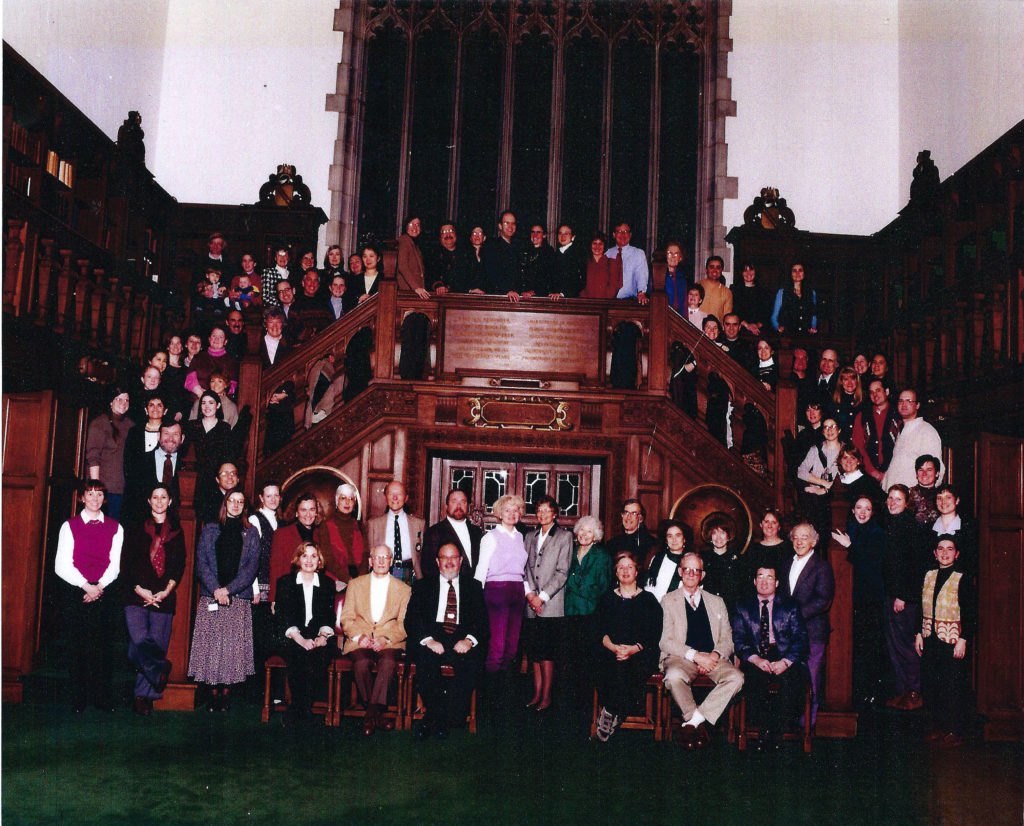
Eleanor McMillan holds a place among the pioneers in the field of conservation. She was instrumental in promoting conservation awareness and training at the Smithsonian, supporting professional organizations and contributing to conservation projects. She had a good heart and was a mensch. She holds a special place in WCG history as a founding member and a past president.
WCG
On October 19, 1967, at a meeting held in the Conservation Analytical Laboratory (CAL) located in the History and Technology Building of the Smithsonian Institution the Washington Region Conservation Guild (WRCG) was formed. In addition to McMillan, those present included Robert Organ, Jacqueline Olin, Maurice Salmon, from CAL; R. J. Gettens and W. T. Chase of the Freer; Elizabeth Packard and Kay Silverfeld from museums in Baltimore; and Peter Powell, General Counsel for the Smithsonian Institution. Robert Organ, head of CAL, was instrumental in the promotion of the conservation profession and encouraged his staff of conservators and scientists to join and participate in the IIC-AG, later the AIC, and the newly formed Washington Region Conservation Guild. Organ had the support of then SI Secretary Dillon Ripley, who made SI facilities available to the Guild. In 1979, Eleanor became Guild President. During her term in office, the name of the WRCG was changed to the Washington Conservation Guild (WCG).
Early History
Prior to joining CAL in 1963, Eleanor graduated from Radcliffe College with a BA, attended the Art Students League in New York and served an internship at the Walters Museum. Her early exposure to conservation focused on paper and she became CAL’s first paper conservator. She would remain with the Smithsonian until her retirement in 1994. In 1969, she was sent to Florence, Italy for four months, part of a larger institutional effort to rescue and conserve flood-damaged artifacts.
CAL/SCMRE/MCI
By 1976, Eleanor was placed in charge of conservators at CAL while Mr. Organ supervised the scientists. Things at CAL did not always run smoothly, as suggested by this excerpt from the India Exhibition, a novel by Richard Timothy Conroy, published in 1992:
Ahead at the end of the north-south corridor, just past what appeared to be an eight-foot-high cut-away mock-up of a ship’s engine gearbox, was the door to the Conservation Analytical Laboratory. As he drew closer, Henry could smell the various reagents and other chemicals employed by the mad scientists within, in their crowded and inadequately ventilated space. To the right of CAL was the door to the Exhibits Design Unit. The designers were equally as crowded and equally as mad as the conservation chemists, but they didn’t smell as bad, at least not in the corridor.
Perhaps there is a bit of truth regarding madness within our profession. By the time CAL moved into new facilities at the SI Museum Support center, circumstances had changed greatly. The vision that Mr. Organ and Dr. Ripley shared for the major role that the Smithsonian would play in the greater conservation community was now diminished. The partnership that SI had promised to the WCG was forgotten. CAL morphed through a number of acronyms before becoming MCI. Mr. Organ retired in 1982 and Eleanor in 1994.
Philanthropy
Eleanor was generous and provided initial funding for the Smithsonian Center for Archives Conservation and the Walters Art Museum’s conservation window which opened in 2009. A tangible gift to the National Museum of American History in 2004 speaks to her whimsical side: it was her powder-blue 1965 Ford Mustang hard top. It was one of the earliest versions of the Mustang. One former member of CAL reports that in 1976 Eleanor was stopped and ticketed for using an inflatable man in order to use the express lanes around DC. For a brief period “Inflatoman” occupied a seat next to her desk in the basement of the History and Technology building. It is not known whether “inflatoman” conveyed with the Mustang.
Eleanor McMillan was born in Baltimore on December 11, 1937 to William and Grace Roosevelt McMillan. She died on July 21, 2021 in Towson, MD. She was 83. Eleanor is survived by her brother William McMillan Jr. and two nieces, Virginia Hull and Eleanor Clark. As her friend and colleague, Ann Hitchcock said, “Eleanor had a great sense of humor, [was] enthusiastic, friendly, fun, cheerfully optimistic and hopeful, charming and more. Eleanor was always happy to answer questions, be helpful and share her knowledge — whether that be on conservation or scuba diving.”